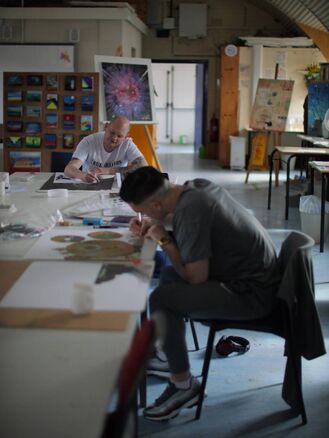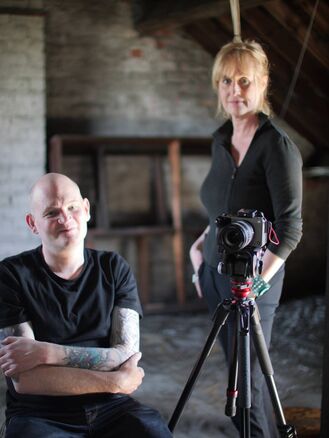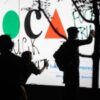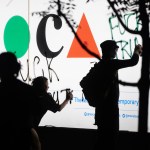Creativity is an inside job, but can art save your life? Stephen Greer is living proof that it can.
The 43-year-old artist from Bangor, Co Down, is an ex-inmate of Magilligan Prison, Co Derry. He’s a convicted terrorist, former drug dealer and addict, and former Loyalist paramilitary, who was sentenced to a total of 42 years, of which he served around six.
A career in art was not on his to-do list.
But Greer was tired of his criminal life, tired of looking over his shoulder.
During his last prison sentence and ready to step away from the chaos, he began attending art classes. This is when everything changed.
Now an art facilitator at Magilligan, he’s just had his first art exhibition in Belfast, and is the subject of a BBC documentary made by award-winning film maker Hilary Fennell.
“Art changed my life,” Greer smiles. Even via Zoom, his effervescent energy transmits. An undiagnosed dyslexic, he left school at 16 – he’d fallen out with his art teacher by then – and got involved with drugs, violence and the paramilitaries. Things quickly escalated, and he ended up in prison in 2004 for two years.
“I did a wee bit of art then,” he says. “But when I got out, I got involved even deeper [with his old life].”
Back in prison again, he decided to educate himself, beginning with a computer course.
“I was moved to Magilligan, and that’s where I met [art teacher] Alison Wilson,” he continues. “I worked as an orderly in the art department. It was really good. Alison gave me confidence in my work; I’d never had any self-belief, but she was a real driving force.”
As well as developing his own work, he helped with art classes, and noticed the effect art had on what he calls the ‘headers’ – “the boys who couldn’t be controlled anywhere in the jail.”
He describes how after showing them the basics of drawing and mixing paint, “Within 10-15 minutes you could hear a pin drop, they were all so into it – and they’d be asking for materials to take back to work in their cells. You could see the difference for everyone involved. Not everyone went on to get a career out of it, but as a hobby for their mental health, it was really good.”
He also had a spiritual awakening in jail when he was “off my head on acid… I asked for a career in art and I would give up my criminality”.
As he got deeper into his art, “It took off, and changed my life.” Not just internally.

He entered the Koestler Awards for arts in criminal justice (he was “quite successful”), had an exhibition in Kilmainham Gaol – the Unlocked Exhibition curated by Tom Shortt, arts officer with the Irish prison service, showing his work alongside that of Eddie Cahill, brother of Martin Cahill.
He also met former Justice Minister Charlie Flanagan at another exhibition at Portlaoise. “Someone from my [Loyalist] background coming to meet the Irish Justice Minister felt quite significant,” he says.
After his release, Greer earned qualifications in art and photography, and went self-employed as a full-time artist.
But during the pandemic, he ended up in hospital with lung, kidney, and heart damage – the result of his time as a cocaine addict – and was put into an induced coma.
His first kidney transplant in 2021 ruptured and almost killed him, but he had another last January, which worked. He had the operation on a Friday and was out the following Monday.
“I should be dead!” he says happily.
Instead, he ended up returning to his old art room to teach art. “My teacher Alison passed away a year after I got out – if I could do for someone what she did for me, it would all be worthwhile,” he says.
“Returning to where I began my art was very emotional.” As well as returning to prison to teach, while on dialysis in between kidney replacements, Greer spotted a notice for the Renal Arts Group, a Queens University initiative involving patients, clinicians, carers, academics and artists. He joined up.
“I’m now their co-chair,” he beams. He works alongside Prison Arts as well.
“Their mentor scheme gave me such focus,” he says. “Hopefully I will become a mentor too, and work with prisoners leaving prison.”
He is very aware of how much his own life has changed. “I was done under the Terrorism Act as well, so for me to be able to go back into prison to teach art with my convictions just shows what can be achieved when you think outside the box,” he says.
“There was a lot of faith in me from Governor [Gary] Milling. It was the first time in my prison life that a governor treated me like an equal. Creative writing, poetry, music, visual art, ceramics – everyone is good at something. It’s so powerful. You just find what you like.”
He describes a Holocaust project he and 13 other prisoners did together, handwriting the names of victims in a Nissen hut, and adding photographs. Of the 14 who took part in that art project, only one re-offended. “It just shows you how powerful art can be,” he says.
Six weeks before his final release, while in an open-prison setup, Greer was caught with cannabis. He says the resulting three days in solitary felt like “three hundred years” because he felt he had let down Governor Milling and others who had placed trust in him.
“It was a final wake-up call,” he says. “But people need to want it. You can put stuff in front of people, but they need to want to engage with it. I’m living proof of that. Someone as far gone as I was – if I can turn my life around, anyone can.”




Film maker Hilary Fennell originally met Stephen Greer when she made , a documentary about five artists all keen to have their work accepted to the Royal Ulster Academy Annual, Northern Ireland’s most important open-call show. Greer was one of the five.
“I didn’t have enough time with Stephen – his story was so huge,” she says. “So I pitched another documentary to the BBC, this time just about him. In , he goes back to Magilligan, his original prison, as an art facilitator.
“It was his first time back there since his release – the last time he’d been there, it had been in the back of a prison van: this time he was going in through the staff door. It was really moving. The effect he has on other prisoners is so positive, because he’s one of their peers, and totally open about his past, about being a drug dealer. He’s so personable. And his students are really talented.”
She was determined to get his story made. “Filming inside prison is really difficult because of all the red tape involved, but every time another obstacle presented, pushed through. I wouldn’t give up.”
- airs on BBC One at 7.30pm on Friday 1st September 2023
This post was originally published on this site be sure to check out more of their content.






